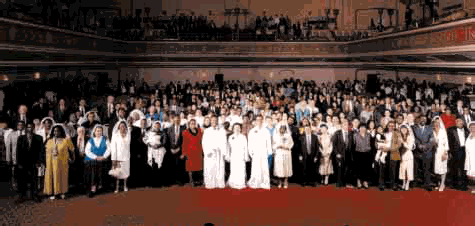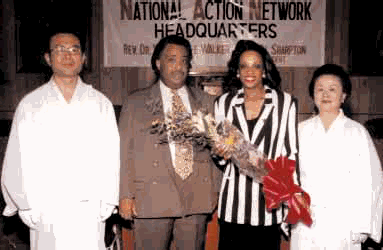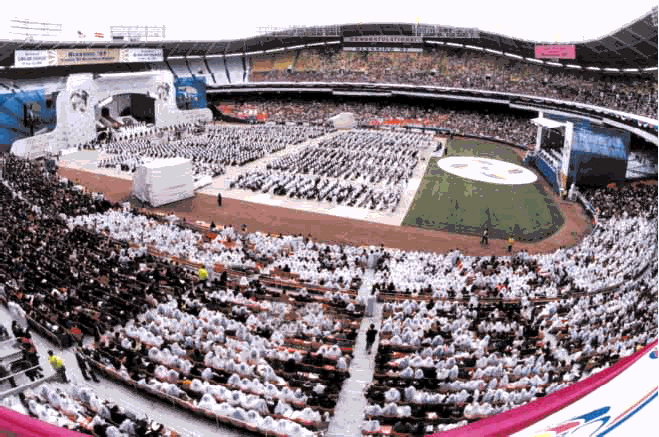
40 Years in America

|
|
40 Years in America |
|
Officiating the Blessing
Edner & Juanita Pierre-Louis

On May 15, 1997 at the historic Manhattan Center, an especially historic event took place, presided over by a man and woman who are history- makers. Weíre speaking of none other than Rev. Al Sharpton and his wife Mrs. Kathy Jordan Sharpton. In the rain, by bus, by train they came to hear words of inspiration and recite vows of rededication of marriage led by Rev. and Mrs. Sharpton.
Nothing could dampen the spirit of the enthusiastic crowd. As the night quickly moved along, there was stimulating music performed by the Henry T. Wilkerson Gospel Combo, a rousing rendition of "Bye and Bye" by the Lady Grace ensemble of Phoenix, Arizona. The groupís leader, Evangelist Elayysandria London, had the crowd on its feet, ready for Rev. Sharpton.
Whatever the difficulties Rev. Sharpton has encountered in his efforts to understand and lead people, it should be clear to all reflective thinkers that his techniques of dealing with them are a vindication of love. And it was an act of love that ushered in the officiation of Rev. and Mrs. Sharpton and Rev. and Mrs. Pak for 21 waiting couples from New York, New Jersey and Connecticut.
In His mercy, God sent Jesus to save us and empower us through the Holy Spirit. Today the Lord is opening the gate of the original Blessing of Marriage. This is the day God and Jesus long desired to see (Rev. 22:14). The officiators were adorned in white Holy Robes. Rev. and Mrs. Sharpton offered the Holy Wine. The Holy Wine Ceremony contains deep spiritual significance. Jesus turned water into wine at the marriage at Cana. Through the Holy Wine Ceremony, God changes our sinful blood lineage into a sanctified blood lineage in preparation to bestow His Holy Blessing.
Rev. and Mrs. Pak sprinkled the Holy Water. The sprinkle of Holy Water represents the sanctifying love of the Father, Son and Holy Spirit upon the couple. John the Revelator told us, "The Spirit and the Bride say ĎCome!í Whoever is thirsty, let him come; and whoever wishes, let him take the free gift of the water of life" (Rev. 22:17). And they came to receive the Blessing of God, and His Holy Communion.
Another highlight of the evening was the crossing of the bridge by husbands and wives. They met in the center of the bridge and embraced. It was like watching two worlds come together in a peaceful manner. This bridge has also been called the bridge of peace, and has been crossed by nations and races. Maybe someday future former Mayor Giuliani and future Mayor Sharpton will cross this bridge at City Hall, and chant together, "No Justice! No Peace!"

The Rev. Al Sharpton and his wife rededicate their marriage with Rev. and Mrs. Joong Hyun Pak.
The liberation of members also helped liberate some of the movementís more influential supporters. A limitation of the True Family Festival approach was that it required a movement officiator. To some extent this was an affront to ministers, especially when the festival was in their churches. Thus, in late May, Rev. T. L. Barrett, who had made his church available previously for pre-Blessings, "asked to be the host and sponsor of the Blessing -- rather than have the UC host the event." As one member explained, "He felt that the Blessing belonged not to the Unification Church -- not to his own Life Center COGIC, but rather to God." Having conducted a highly successful ceremony in his church for sixty-one couples, Rev. Barrett continued "to be on the forefront of Godís work." In New York, the Rev. Al Sharpton and his wife rededicated their marriage in a pre-Blessing ceremony and then officiated at several more. In a memorable response to exposure of his association with Rev. Moon and the True Family Values Ministry, he stated,
[T]he world needs the message of true families. I donít care if it comes from Rev. Moon, Rev. Sun, or Rev. Midnight. This is the message God is sending us today.
That Rev. Sharpton, a high-profile public figure and Democratic mayoral hopeful, was unapologetic about his participation in Blessing activities inspired other prominent clergy and elders to rededicate their marriages.
Blessing fever legitimately hit Unification communities during the summer and totals skyrocketed. Washington, D.C. members, working the Capitol Mall as well as residential areas, pre-Blessed 12,000 couples by the end of June. On July 4-5th, some 50 Minnesota members pre-Blessed 3,112 couples at a Hmong sports festival. On August 3rd, Rev. Joon Hyun Pak reported that 210,000 couples nationwide had been pre-Blessed, including 500 ministers. The hill of the Blessing was being surmounted, and the U.S. moved into the rank of leading nations in terms of Blessing count. More importantly, Rev. Pak could speak of "wonderful miracles" occurring. To be sure, quality-control measures were lacking, but members were having phenomenal experiences. They had discovered a message and a medium with which to engage the wider public at a mass level. Many, for the first time, had the feeling of being not simply a follower of Rev. Moon but a spiritual leader. This may have been the true miracle and blessing.
By mid-summer, it became obvious that 3.6 million couples worldwide were pre-Blessed. In fact, Rev. Chung Hwan Kwak conducted a ceremony in Seoul on July 16th to commemorate the goal being surpassed. On August 9th, July 7th according to the lunar calendar, Rev. Moon proclaimed the "Declaration of the Realm of the Cosmic Sabbath for the Parents of Heaven and Earth." This was later termed "Seven-Eight Day" as it was proclaimed in 1997, in the seventh month, on the seventh day, at the seventh hour, the seventh minute, the seventh second and it was his seventy-seventh birth year. There also were 7,777 to four nations with the top pre-Blessing results. They were Korea with 1,051,852; the Philippines with 952,281; Nigeria with 748,814; and Ghana with 658,000. The U.S. placed ninth with a pre-Blessing total of 173,611 reported as of July 15th. There was a sense of vindication. Rev. Joong Hyun Pak, who attended the Seven-Eight Day ceremony, reported that many important leaders told him "how inspired they were" and "how secure it made them feel" to hear the U.S. result.
Although a cosmic sabbath had been declared, there was little rest for the movementís worldwide membership prior to November 29th as Rev. Moon accelerated the Blessing schedule. Previously, he intended to conduct a 36 Million Couple Blessing after Blessing 3.6 million couples. Now, as a result of the progress made, he decided to combine the two. Therefore, the goal for the RFK Blessing was increased to 39.6 million couples. Over the next four months, the worldwide result exploded with countries such as the Sudan, Nigeria and the Ukraine reporting totals in excess of seven, nine and ten million couples. The thrust in the U.S. was different. Some tribal messiah couples, particularly those west of the Mississippi River, continued pre-Blessings. However, the main focus shifted to preparations for the Third World Culture and Sports Festival in Washington, D.C. and the mobilization of pre-Blessed couples to fill RFK Stadium.
The American movementís strategy for the WCSF was to make it not so much a Unification Church or even a Family Federation for World Peace and Unification event as a Washington, D.C. event. The movement already had a strong media and arts presence through The Washington Times and Kirov Ballet Academy. These connections helped WCSF III staff establish working relationships with a number of city officials. The theme that was adopted, "Rebuilding the Family, Restoring the Community, Renewing Washington," reflected the organizersí hope that WCSF III would appeal to the cityís mainstream. The movement formed a large "welcoming committee" and secured an official invitation. According to Dr. Tyler Hendricks,
This is WCSF III, but it is also a Washington renaissance festival! The entire city will be transformed. And the intent is to make the impact a lasting one; not just to fold up our tents after Nov. 29. We want to create a foundation for the future and a model for the regeneration of our cities and nation.... Of course, the foundation is the grassroots door-to-door, heart-to-heart life for the sake of others. But what is new, in America at least, is the preparation of the soil and the potential for important institutional revival, centered on marriage and family, beyond race, nation, and religion.
These were heady sentiments. Whether the movement could pull together all the contacts it had established with Christian ministers, conservative educators and media, academics, business types, and now civic officials into a coherent urban-renaissance package was, perhaps, doubtful. However, it appeared to be the direction Rev. Moon wished to go. He wanted the WCSF and Blessing to be popular events, exerting broad appeal. The first two World Culture and Sports Festivals, held in Korea, were rather isolated and movement-centered affairs. They consisted largely of conferences in expensive hotels and stadium Blessings. Significant numbers of couples participated from outlying regions and rural areas, but there was not the sense that the festivals penetrated mainstream Korean culture. This, undoubtedly, was one reason why the movement moved WCSF III to the U.S.
On October 29th, WCSF III Chairman, Rev. Chung Hwan Kwak, held a press conference at the National Press Club at which he provided background information and schedule details about the November 23-30th festival. He also cited Rev. Moon as saying, "There can only be a peaceful family of nations when you have nations of peaceful families." As with previous festivals, the schedule included an array of conferences, a youth sports competition and the Blessing. These were to be complemented by week-long cultural activities: an international art exhibit, jazz concert, various classical recitals, ballet, and a "Love Alive Concert" to benefit The Hospital for Sick Children of Washington, D.C. In addition, there would be a parade and rally by the Pure Love Alliance, a national movement-related organization which promoted sexual abstinence. The Blessing, billed as "True Love Day at RFK," was to include such world-class entertainers as Latin pop idol Jon Secada, Korean rock superstar Cho Young Pil and American Grammy Award winning singer- actress Whitney Houston. A twilight laser and fireworks display was to conclude the event.

Blessing í97 at RFK Stadium in Washington, D.C.
It was fairly obvious even by October 29th that WCSF III would fall short of "restoring the community" and "renewing Washington." A stronger case could be made for the Festivalís role in "rebuilding the family." However, even if this were not conceded, so long as WCSF III was accepted by the local establishment, it still would be counted as an advance. Here the movement got off to a promising start. Mayor Marion Barry extended a written letter of welcome and held a press conference at city hall with WCSF organizers. In response, Rev. Kwak pointed out that the first two festivals had no official invitation or welcome and that "extensive positive press coverage" about WCSF III prompted an invitation for WCSF IV from the government of a "big Asian country."
The mobilization of 30,000 pre-Blessed couples to fill RFK Stadium was the top priority of members in the field. The general direction was each tribal messiah family within reasonable driving distance of Washington, D.C. should bring twenty pre-Blessed couples, or a single busload. The movement chartered busses and arranged for motel lodgings in the greater D.C. area. It also arranged for various package rates for round-trip transportation, food, overnight lodging, and admission to the stadium event. Most trips also included a monument tour. Costs were kept low. For example, the upstate New York fee was $160 per couple. Fees were less for those residing closer and more for those farther away. However, in many cases, tribal messiahs helped or entirely subsidized payments.
Still, members had to find pre-Blessed couples to attend. This required deeper relationships with their couples. For members who adopted a scattergun approach to pre-Blessings or who failed to record names and addresses on the Blessing forms, follow-up was exceedingly difficult, if not impossible. For those who had worked more systematically in residential areas and kept adequate records, including photographs of pre-Blessed couples, the task was easier. Members were often surprised that couples pre-Blessed in relatively simple, usually less-than-five-minute ceremonies remembered the occasions so clearly. However, it was one thing to be remembered and even invited warmly back into living rooms. It was another to mobilize pre-Blessed couples for departures by bus for Washington, D.C. the Friday after Thanksgiving at a cost of $100 or more.
Some pre-Blessed couples were inspired and agreed to attend immediately. Others required convincing. Members found themselves pressed into new levels of spiritual leadership. They had to visit and re-visit contacts. They had to educate them more deeply about the Blessing and, on occasion, offer counsel. They had to coordinate schedules and logistics, handle money, and manage group dynamics. In short, they had to minister. A large number of members worked the residential areas of Washington, D.C., Maryland and northern Virginia and several hundred buses were chartered to circulate back and forth from selected pick-up points. These were methods used with success twenty-one years before during the movementís Washington Monument Campaign in 1976. However, the Washington Monument rally was conducted during the summer. Blessing í97 was to be an open-stadium event in late November. For their part, organizers thoughtfully included plastic ponchos and seat warmers with the Blessing programs and hoped for the best.
In most respects, they were not disappointed. The front-page headline in the December issue of Unification News described Blessing í97 at RFK as a "Resounding Victory." In the lead piece, Richard Lewis commented on "the unseasonably balmy air," the "crowds everywhere," the paltry number of demonstrators whom he described as "[q]uite a drop from the massed protestors we had to run the gauntlet of at Yankee Stadium," the impressive satellite transmission equipment, the breathtaking stage, banners and Jumbotrons, the Blessing shawls that everyone wore, the greetings from six representatives of the worldís religions, the "break in the clouds" just as "True Parents raised their hands to proclaim the victory," the cheers of "mansei" (ten thousand years), the entertainment and spontaneous "boogying all over the field," and the "fabulous" fireworks. Of course, not everything could be perfect. Lewis acknowledged that the entertainment programís headliner, Whitney Houston, was a no-show. However, he cited national communications director Michael Smith who, when asked to comment on what her absence meant, replied, "In a word: refund."
The mainstream media generally ran straightforward and respectful accounts of the event. However, during the preceding week, The Washington Post published a series of articles that depicted Blessing í97 as a "Moonie" affair. Chris Corcoran, the churchís public relations director, pointed out that it was the first major newspaper to use that epithet in an article about the Festival. The series, as a whole, depicted the Unification Church as a cult, its members as barely knowing their church-selected marriage partners, and questioned whether WCSF III was a "Festival of Faith or Self-Promotion?" The series unfortunately had a chilling effect locally. Mayor Barry decided to spend the weekend out of town, and local Catholics ran spots on Spanish radio discouraging the faithful from attending. It also may have helped induce Whitney Houstonís sudden illness. More importantly, the series ran directly counter to the movementís core strategy of making WCSF a Washington, D.C. event. The movement hoped that WCSF III would appeal to the cityís mainstream. That obviously had not happened. In fact, The Washington Post did its utmost to consign WCSF and the movement back to the margins of society.
What saved the event was the presence of so many ordinary people. It was one thing to dump on the "Moonies" who could be counted upon to be arranged in neat rows with identical suits and gowns. They were easy targets. It was more difficult and risky to take on a stadium-full of normal folk. A substantial number of mostly Black ministers and members of their congregations had come by bus from as far away as Chicago. In addition, East coast members successfully bused in a rainbow coalition of pre-Blessed couples. The Washington Post set attendance at 40,000, CNN put it as 45,000, and the Associated Press counted 28,000 couples/56,000 people. Railing against this group, most of whom were minorities, would be politically incorrect. Besides, almost all of them appeared to be having a great time. In effect, the pre-Blessed couples formed a protective ring around the 2,500 or so church member brides and bridegrooms on the stadium floor.
The media picked up on this and distinguished between the "mass wedding" and "marriage rededication" aspects of the ceremony. However, the question was whether the movement shared this double-consciousness, whether there were two categories of sanctification. The opening of the Blessing, the lessening of ritual requirements, the empowerment of members and even pre-Blessed couples to conduct Blessings, and the determination of WCSF III organizers to go mainstream reflected a universal approach. Yet the segregation of "newly-matched" member couples on the stadium floor from previously married couples in the bleachers suggested that the transition from closed to open Blessings had not yet been fully realized. It raised the issue of whether some couples might be more blessed than others. This was not experienced as a tension at RFK. Nevertheless, as the numbers zoomed into the hundreds of millions, questions as to the meaning and purpose of mass Blessings arose for many.
Download entire page and pages related to it in ZIP format
Table of Contents
Information
Tparents Home